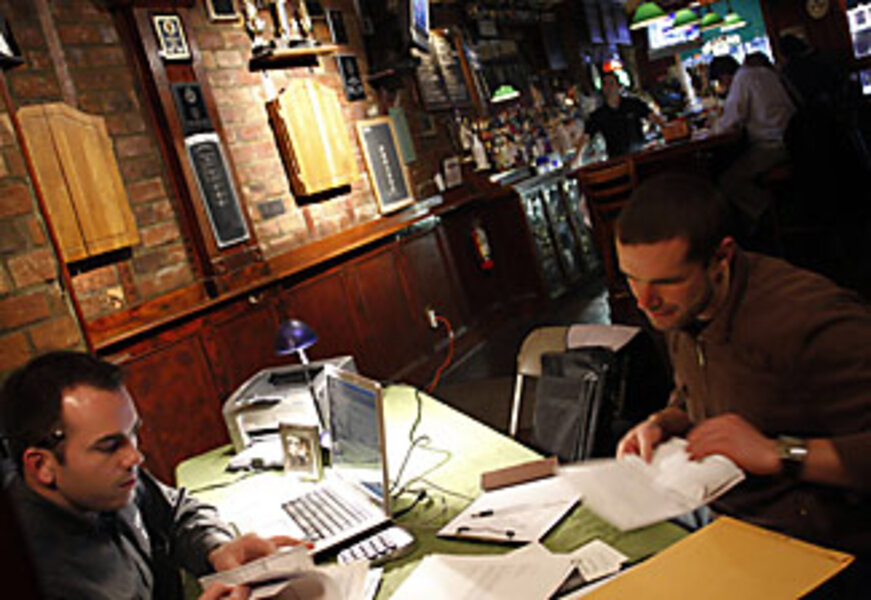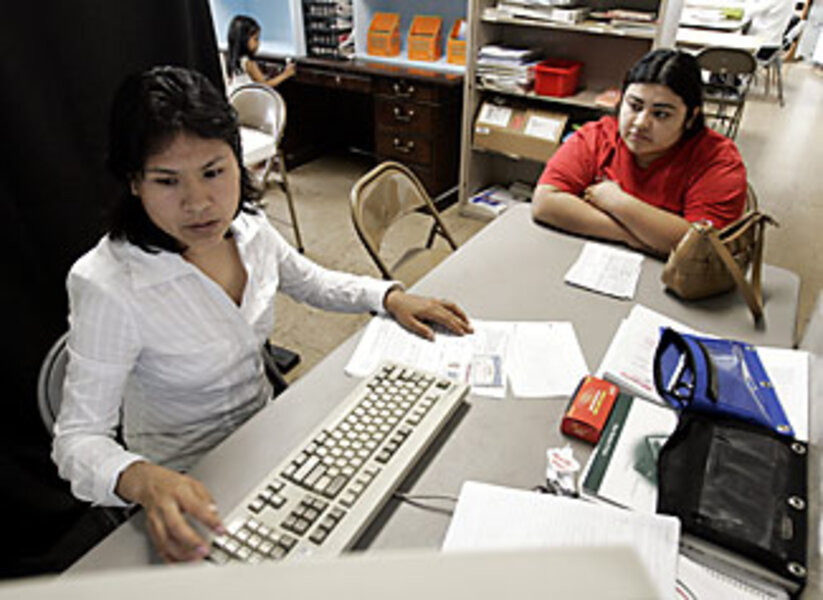Will the Simple Return end April 15 tax agony?
| Oakland, Calif.
Every year, Americans spend millions of hours filling out tax forms that show the federal government what it already knows: income, interest earned, and interest paid.
If it's all in government databases anyhow, why not save taxpayers the hassle and give them forms with that information already filled in and calculated?
That's the idea behind the Simple Return, and as today's tax-filing deadline arrives, thousands of Californians will have completed a version of it. It's a system gaining its advocates, among them presidential hopeful Barack Obama: his chief economic adviser is one of its architects.
Simple Returns could be used by 40 percent of Americans who have basic tax liabilities, saving them 225 million hours of preparation time and more than $2 billion in tax-preparation fees, proponents estimate. Convert that time into money, and the savings jump to $44 billion over 10 years.
"Think of a tax return like a Visa bill. Visa doesn't send you a blank piece of paper and say, 'Write down all your transactions.' They send you a printout and they say, 'Look it over,' " says Joseph Bankman, a Stanford University law professor who helped devise the ReadyReturn, California's version of the Simple Return.
Opponents including members of the tax-software industry and small-government conservatives warn that the Simple Return weakens taxpayers' position vis-à-vis the tax collector.
"It shifts the initiative. If the first step in doing your taxes is having the IRS send you the bill, it's pretty clear who is in the driver's seat at that point," says Ryan Ellis, director of tax policy at Americans for Tax Reform, an antitax advocacy group in Washington. "You've got the taxpayer, this isolated person, having to fight the IRS on a battlefield of the IRS's choosing. That's just not right."
A straightforward beginning
The idea so far has been envisioned only for simpler types of returns, the ones least open to the adversarial negotiation that Mr. Ellis wants to keep in balance.
California's ReadyReturn is available only for residents filing as a single head of household, with only one employer, no dependents, no itemizing, and no special credits. The state estimates that about 1 million Californians are eligible. The program is voluntary and free of charge.
If there were a TurboTurboTax, this would be it. A resident can go to the state's website, plug in their name, Social Security number, and answers to security questions, and if they qualify, staring at them will be their state tax return with the bubbles, boxes, and lines already filled in.
Yes, Virginia, line 14 has been subtracted from line 13, and if line 14 was more than line 13, zero was entered – though if anything looks amiss, a taxpayer can make fixes to the form.
That simplicity reflects some tax-filing systems abroad. Denmark and Sweden have used systems like Simple Return for at least a decade.
"There are lots of countries with an income tax, and lots with basically our system. But we make the filing part harder than any other country," says Mr. Bankman.
The ease of ReadyReturn, however, hasn't drawn in the public in droves yet. During the pilot phase in 2004-05, California officials mailed out 100,000 ReadyReturns and got back 22,000. This year, the state made the program permanent, but opted not to mail out returns. As of last week, slightly more than 6,500 Californians had taken part.
Members of the tax board see no downsides so far and will look at ways to boost participation, says a spokesperson.
Three-phased rollout
Simple Return would be rolled out in stages that would gradually include more taxpayers. In a 2006 paper published by the Brookings Institution in Washington, Mr. Obama's adviser Austan Goolsbee outlined three phases. The first looks like the ReadyReturn and would include joint filers. Phase 2 allows for the reporting of other kinds of income such as interest and dividends. The final step would incorporate those who don't itemize.
The later stages cut into territory staked out by tax-service providers. Only 10 percent of taxpayers fill out their own forms on paper these days, says Bankman. There are now an estimated 1.2 million tax-return preparers. And TurboTax, the dominant tax-preparation software, brought in $813 million for Intuit last year.
Intuit spent $1 million in 2006 trying to unseat a ReadyReturn proponent in California, and the Computer & Communications Industry Association raised objections to Simple Return systems in a 2006 report.
Suggesting the process would be redundant, the report decried the government investing in and developing "competitive electronic commerce initiatives, launching products and services that use public funds to duplicate those offered by the private sector."
The report also noted that cost savings to individual taxpayers "may be trivial," since it involves those with the simplest returns that cost the least to fill out. Many would qualify for free e-filing under a program offered by the federal government and software-makers including Intuit. "There's no up-sell to it, it's just a free offering," says Intuit spokeswoman Diane Carlini.
Ellis with Americans for Tax Reform says the IRS would calculate returns to its advantage, and Congress could more easily raise taxes without people noticing.
"It's a nice way to get people completely disengaged from the tax-policy process," he says.
The program has also met opposition from the California legislature, which, under intense lobbying, was moving toward killing the ReadyReturn program in 2006 when the tax board did an end-run around them.
Bankman says the voluntary system empowers taxpayers by showing them information the government has.
And taxpayers? Polling contracted by the Internal Revenue Service in 2000 found that just 39 percent of eligible US taxpayers were interested in a system like Simple Return and would be impatient if it delayed refunds by two months or more.
Refund delays would be likely for those who file in January or February, according to a 2003 Treasury Department study. There are also dueling federal estimates on whether Simple Return would cost the government or save it money.






